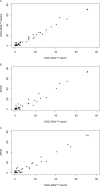Circulating tumor DNA dynamic variation predicts sotorasib efficacy in KRASp.G12C-mutated advanced non-small cell lung cancer
- PMID: 40445863
- PMCID: PMC12124469
- DOI: 10.1002/cncr.35917
Circulating tumor DNA dynamic variation predicts sotorasib efficacy in KRASp.G12C-mutated advanced non-small cell lung cancer
Abstract
Background: The objective of this study was to investigate the correlation between circulating tumor DNA (ctDNA) KRAS G12C-mutation dynamic variations and treatment outcomes in patients with advanced non-small cell lung cancer (NSCLC) receiving sotorasib therapy in a real-world setting.
Methods: Peripheral blood samples were prospectively collected from 32 patients at baseline, at cycle 3, and then at each radiologic assessment during sotorasib treatment. Both tissue and plasma samples were analyzed by using ultra-deep, customized next-generation sequencing (NGS) assays. Plasma samples from 27 of 32 patients also were analyzed by digital polymerase chain reaction analysis, and ctDNA dynamic variations were correlated with radiologic responses and patients' clinical outcomes.
Results: A significant correlation between NGS and digital polymerase chain reaction-detected KRAS G12C variant allelic fractions (p < .001) was observed. Patients who achieved clearance of KRAS G12C-mutant ctDNA levels had a significant improvement in the objective response rate (80% vs. 8%; p < .001), median progression-free survival (7.9 vs. 2.8 months; p < .001), and median overall survival (16.8 vs. 6.4 months; p < .001) compared with those who did not achieve clearance. The clearance of ctDNA was the only prognostic factor significantly associated with both median progression-free survival (hazard ratio, 0.15; 95% confidence interval, 0.04-0.48) and median overall survival (hazard ratio, 0.09; 95% confidence interval, 0.02-0.45) in multivariable analysis. Moreover, a dynamic increase in the KRAS G12C median variant allele fraction anticipated radiologic disease progression in 70% of patients who were evaluable at the resistance time point.
Conclusions: This study demonstrated that early clearance of KRAS G12C-mutant ctDNA predicted the clinical benefit of sotorasib in patients with advanced NSCLC, suggesting that dynamic monitoring of ctDNA levels also may anticipate sotorasib resistance.
Keywords: KRASp.G12C; circulating tumor DNA; liquid biopsy; non‐small cell lung cancer (NSCLC); sotorasib.
© 2025 The Author(s). Cancer published by Wiley Periodicals LLC on behalf of American Cancer Society.
Conflict of interest statement
Francesco Passiglia reports personal/consulting and/or advisory fees from Amgen, AstraZeneca, BeiGene, Bristol Myers Squibb, Janssen, Merck Sharp and Dohme, Novartis, Pfizer, PharmaMar, Roche, and ThermoFisher Scientific outside the submitted work. Francesco Pepe reports personal/consulting and/or speakers' bureau fees from Menarini International and Roche outside the submitted work. Massimiliano Cani reports travel support from Amgen and AstraZeneca outside the submitted work. Chiara Ambrogio reports grants/contracts from Boehringer Ingelheim and Verastem Inc. outside the submitted work. Luisella Righi reports consulting/advisory fees from AstraZeneca, Boehringer Ingelheim, Eli Lilly & Company, Novartis, and Roche outside the submitted work. Marcello Tiseo reports institutional research grants from AstraZeneca, Boehringer Ingelheim, and Roche; personal/consulting and/or speakers' fees from Amgen, AstraZeneca, BeiGene USA Inc., Boehringer Ingelheim, Bristol Myers Squibb, Daiichi Sankyo, Eli Lilly & Company, F. Hoffmann‐La Riche, Johnson & Johnson Health Care Systems Inc., Merck, Merck Sharp and Dohme, Novartis, Pfizer, Pierre Fabre Pharmaceuticals, and Takeda Oncology; and travel support from Amgen and Takeda Oncology outside the submitted work. Diana Giannarelli reports personal/consulting and/or advisory fees from AstraZeneca, Amgen, and Sanofi outside the submitted work. and Amgen. Giancarlo Troncone reports personal advisory or speakers' fees from Bayer, Merck Sharp & Dohme, Roche, and Pfizer outside the submitted work. Silvia Novello reports grants/contracts from Amgen, AstraZeneca, BeiGene Switzerland GmbH, Boehringer Ingelheim, Eli Lilly and Company, F. Hoffman La‐Roche, Merck Sharp and Dohme, Novartis, Pfizer Canada Inc., and Takeda Oncology; and support for professional activities from AstraZeneca, BeiGene Switzerland GmbH, Bristol Myers Squibb, Novartis, Takeda Oncology, and ThermoFisher Scientific outside the submitted work. Umberto Malapelle reports personal/consulting or speakers' bureau fees from AstraZeneca, Amgen, Boehringer Ingelheim, Diaceutics, Diatech, Eli Lilly & Company, GlaxoSmithKline, Hedra, Janssen Biotech, Merck, Merck Sharp & Dohme, Novartis, Roche Health Solutions Inc., and ThermoFisher Scientific outside the submitted work. The remaining authors disclosed no conflicts of interest.
Figures




References
MeSH terms
Substances
LinkOut - more resources
Full Text Sources
Medical
Miscellaneous

